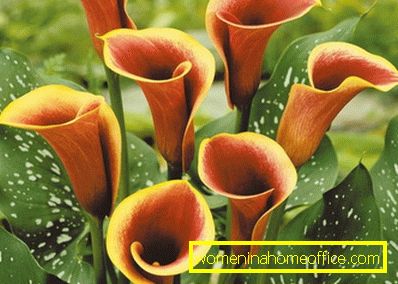Houseplant calla
Calla, or calla, exists in nature as a marsh plant. It grows in swampy and humid places, along the swampy shores of water bodies and rivers. In floriculture is grown as an ornamental plant. Calla is used in landscape design.
There are callas, both garden and indoor.
Indoor Calla belong to the group of ornamental flowering plants.
Appearance of calla
Under natural conditions, calla reaches a height of 80 cm. The plant has a fleshy, stem-like rhizome, thanks to which it takes moisture deep out of the ground. The leaves of this plant is a juicy green color. During the flowering period, the arrow-shaped flower sprout grows, which reaches one meter in height. It ends with an icy-shaped inflorescence, wrapped in a snow-white veil - with a covering sheet. The color of the inflorescence can be not only white, but also pink, orange or yellow. Small yellow flowers smell dearly, reminding a smell of vanilla. Calla blooms mostly in spring. If the fruit is tied, it is better to remove them, so as not to deplete the plant.

Callas look great in the garden. But low-growing varieties of callas are usually grown at home as indoor plants. For the successful cultivation of callas, you must remember that they definitely need a pronounced period of rest. This is winter.
Location in the house
Kallu can be placed in the living room, bedroom and nursery. Any other room in your home will do as well if you follow the conditions of plant care.
You can arrange it both on the sunny windowsill and on the north, poorly illuminated side. In the summer, it is best to choose the partial shade, and in the winter to put the plant closer to the light window.

If you want to plant calla in the garden, then you must choose a place protected from direct sunlight, from drafts and wind.
Calla Care
Very often, they buy blooming callas in the store, bring them home and put them on the sunniest place. But for some reason, the flowering gradually stops, the leaves become small, yellowish. By the fall, the plant "dies" - all its leaves die off. In fact, it only goes into a state of rest. And we can throw it away by mistake, to think that the calla is a naughty and unfit for flowers room. However, if you know the main features of care for this exotic plant, then you can successfully grow it for many years.
Conventionally, callas are divided into two groups: white and color (gently pink, yellow, orange). They require a bit of different care. White callas are moisture-loving, bloom longer, do not shed their leaves during the rest period. The colored ones are less demanding of the humidity of the air and the soil, they like bright scattered light and during the rest period they completely shed their leaves.

- Lighting.For the successful growth and development of callas, a bright location in the house is necessary, but penumbra can also be.
- Temperature in winter, it should be 8 ° С -12 ° С, higher in the rest of the year.
- Air humidity should be good.
- Watering.Kalla is a very moisture-loving plant, so the soil should never dry out. Can be done at the bottom of the pot drainage, which will always be water. It is also useful to plant the plant in a container filled with water. It is also important to note that earthworms are useful for the plant in a pot. Thanks to them, the processing of applied organic substances into humus is accelerated in the soil. Also worms produce loosening and enrich the soil with oxygen.
- Breedsin the summer at the time of transplantation by dividing the maternal rhizome, as well as individual daughter tubers.
- TransplantedThe plant must be in a new substrate after flowering. As for the previous period, it took from the soil all the necessary minerals, depleting it.

Pests and diseases
If the maintenance conditions are not observed, the callas are damaged by a shield and a spider mite.
It must be remembered that callamas need frequent feeding and high humidity of air and soil. However, feeding after the end of flowering should stop, as well as reduce watering.
Observing all the necessary conditions for the care of calla, you guarantee the long existence of this plant in your home.